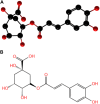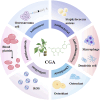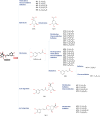Osteogenic mechanism of chlorogenic acid and its application in clinical practice
- PMID: 38873428
- PMCID: PMC11169668
- DOI: 10.3389/fphar.2024.1396354
Osteogenic mechanism of chlorogenic acid and its application in clinical practice
Abstract
Natural polyphenols may have a role in counteracting oxidative stress, which is associated with aging and several bone-related diseases. Chlorogenic acid (CGA) is a naturally occurring polyphenolic compound formed by the esterification of caffeic and quininic acids with osteogenic, antioxidant, and anti-inflammatory properties. This review discusses the potential of CGA to enhance osteogenesis by increasing the osteogenic capacity of mesenchymal stem cells (MSCs), osteoblast survival, proliferation, differentiation, and mineralization, as well as its ability to attenuate osteoclastogenesis by enhancing osteoclast apoptosis and impeding osteoclast regeneration. CGA can be involved in bone remodeling by acting directly on pro-osteoclasts/osteoblasts or indirectly on osteoclasts by activating the nuclear factor kB (RANK)/RANK ligand (RANKL)/acting osteoprotegerin (OPG) system. Finally, we provide perspectives for using CGA to treat bone diseases.
Keywords: chlorogenic acid; osteoblast; osteoclast; osteoporosis; periodontitis.
Copyright © 2024 Shen, Zhang, Zhang, Wei, Wang and Han.
Conflict of interest statement
The authors declare that the research was conducted in the absence of any commercial or financial relationships that could be construed as a potential conflict of interest.
Figures







Similar articles
-
Aging increases stromal/osteoblastic cell-induced osteoclastogenesis and alters the osteoclast precursor pool in the mouse.J Bone Miner Res. 2005 Sep;20(9):1659-68. doi: 10.1359/JBMR.050503. Epub 2005 May 2. J Bone Miner Res. 2005. PMID: 16059637
-
Cross-talk between the interleukin-6 and prostaglandin E(2) signaling systems results in enhancement of osteoclastogenesis through effects on the osteoprotegerin/receptor activator of nuclear factor-{kappa}B (RANK) ligand/RANK system.Endocrinology. 2005 Apr;146(4):1991-8. doi: 10.1210/en.2004-1167. Epub 2004 Dec 23. Endocrinology. 2005. PMID: 15618359
-
Osteoprotective Roles of Green Tea Catechins.Antioxidants (Basel). 2020 Nov 16;9(11):1136. doi: 10.3390/antiox9111136. Antioxidants (Basel). 2020. PMID: 33207822 Free PMC article. Review.
-
Propofol attenuates osteoclastogenesis by lowering RANKL/OPG ratio in mouse osteoblasts.Int J Med Sci. 2018 May 14;15(7):723-729. doi: 10.7150/ijms.22713. eCollection 2018. Int J Med Sci. 2018. PMID: 29910677 Free PMC article.
-
Osteoclast differentiation by RANKL and OPG signaling pathways.J Bone Miner Metab. 2021 Jan;39(1):19-26. doi: 10.1007/s00774-020-01162-6. Epub 2020 Oct 20. J Bone Miner Metab. 2021. PMID: 33079279 Review.
Cited by
-
Effect of nHA/CS/PLGA delivering adipose stem cell-derived exosomes and bone marrow stem cells on bone healing-in vitro and in vivo studies.Sci Rep. 2024 Nov 11;14(1):27502. doi: 10.1038/s41598-024-76672-8. Sci Rep. 2024. PMID: 39528545 Free PMC article.
-
Coffee and tea consumption on the risk of osteoporosis: a meta-analysis.Front Nutr. 2025 Mar 4;12:1559835. doi: 10.3389/fnut.2025.1559835. eCollection 2025. Front Nutr. 2025. PMID: 40104819 Free PMC article.
-
Osteoprotective Activity of Sambucus javanica Reinw Ex Blume subsp. javanica Leaf Extracts by Suppressing ROS Production.Antioxidants (Basel). 2025 Feb 21;14(3):252. doi: 10.3390/antiox14030252. Antioxidants (Basel). 2025. PMID: 40227226 Free PMC article.
-
Effects of Eriobotrya japonica (Thunb.) Lindl. Leaf Extract on Zebrafish Embryogenesis, Behavior, and Biochemical Pathways.Molecules. 2025 Aug 3;30(15):3252. doi: 10.3390/molecules30153252. Molecules. 2025. PMID: 40807427 Free PMC article.
References
-
- Arfian N., Wahyudi D. A. P., Zulfatina I. B., Citta A. N., Anggorowati N., Multazam A., et al. (2019). Chlorogenic acid attenuates kidney ischemic/reperfusion injury via reducing inflammation, tubular injury, and myofibroblast formation. Biomed. Res. Int. 2019, 5423703. 10.1155/2019/5423703 - DOI - PMC - PubMed
Publication types
LinkOut - more resources
Full Text Sources
Research Materials

